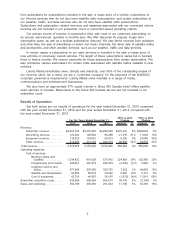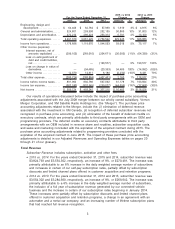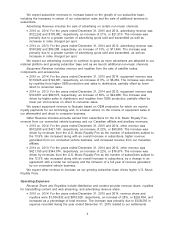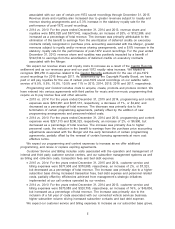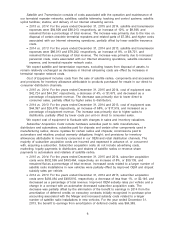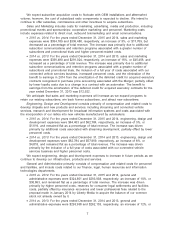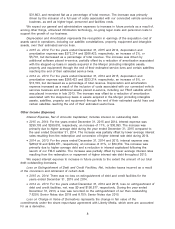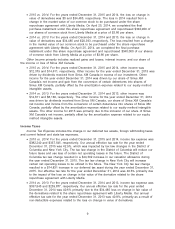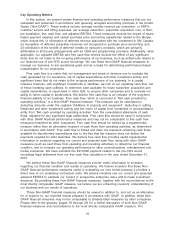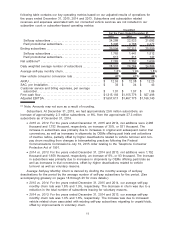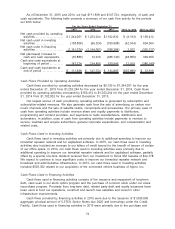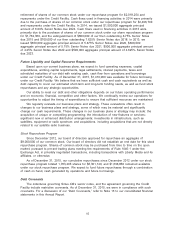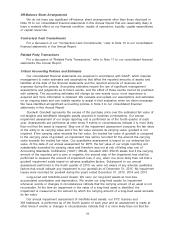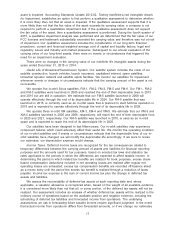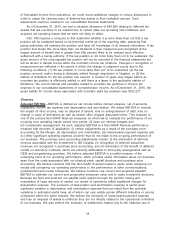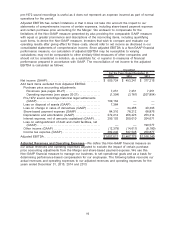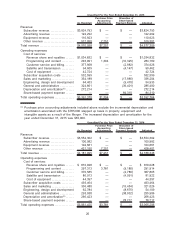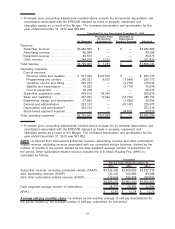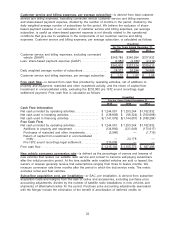XM Radio 2015 Annual Report Download - page 76
Download and view the complete annual report
Please find page 76 of the 2015 XM Radio annual report below. You can navigate through the pages in the report by either clicking on the pages listed below, or by using the keyword search tool below to find specific information within the annual report.New Vehicle Consumer Conversion Rate is the percentage of owners and lessees of new
vehicles that receive our service and convert to become self-paying subscribers after an initial
promotional period. The metric excludes rental and fleet vehicles. (See accompanying glossary on
pages 18 through 23 for more details).
•2015 vs. 2014: For the years ended December 31, 2015 and 2014, the new vehicle
consumer conversion rate was 40% and 41%, respectively. The decrease in conversion was
primarily due to an increased vehicle penetration rate and the effect of the suspension of
certain outbound calling efforts by our vendors as they evaluated the Federal
Communications Commission’s July 10, 2015 order relating to the Telephone Consumer
Protection Act of 1991, partially offset by improvements in converting previously active
subscribers during a trial.
•2014 vs. 2013: For the years ended December 31, 2014 and 2013, the new vehicle
consumer conversion rate was 41% and 44%, respectively. The decrease in the new vehicle
consumer conversion rate was primarily due to an increased vehicle penetration rate and
lower conversion of first-time satellite enabled car buyers and lessees in lower priced
vehicles.
ARPU is derived from total earned subscriber revenue (excluding revenue derived from our
connected vehicle services business), net advertising revenue and other subscription-related
revenue, net of purchase price accounting adjustments, divided by the number of months in the
period, divided by the daily weighted average number of subscribers for the period. (For a
reconciliation to GAAP see the accompanying glossary on pages 18 through 23 for more details.)
•2015 vs. 2014: For the years ended December 31, 2015 and 2014, ARPU was $12.53 and
$12.38, respectively. The increase was driven primarily by increases in certain of our
subscription rates, partially offset by growth in subscription discounts and limited channel
plans offered through customer acquisition and retention programs, and a shift to longer-term
promotional data service plans with lower rates.
•2014 vs. 2013: For the years ended December 31, 2014 and 2013, ARPU was $12.38 and
$12.23, respectively. The increase was driven primarily by the contribution of the U.S. Music
Royalty Fee, and the impact of the increase in certain of our subscription rates beginning in
January 2014. The positive result was partially offset by growth in subscription discounts and
limited channel plans offered through our customer acquisition and retention programs,
lifetime subscription plans that had reached full revenue recognition and changes in contracts
with an automaker and a rental car company.
SAC, Per Installation, is derived from subscriber acquisition costs and margins from the sale of
radios, components and accessories, excluding purchase price accounting adjustments, divided by
the number of satellite radio installations in new vehicles and shipments of aftermarket radios for
the period. (For a reconciliation to GAAP see the accompanying glossary on pages 18 through 23
for more details.)
•2015 vs. 2014: For the years ended December 31, 2015 and 2014, SAC, per installation,
was $33 and $34, respectively. The decrease was primarily due to lower subsidies on
chipsets and improvements in contractual OEM rates.
•2014 vs. 2013: For the years ended December 31, 2014 and 2013, SAC, per installation,
was $34 and $43, respectively. The decrease was primarily due to improvements in
contractual OEM rates.
Customer Service and Billing Expenses, Per Average Subscriber, is derived from total customer
service and billing expenses, excluding connected vehicle customer service and billing expenses
and share-based payment expense, divided by the number of months in the period, divided by the
daily weighted average number of subscribers for the period. (For a reconciliation to GAAP see the
accompanying glossary on pages 18 through 23 for more details.)
•2015 vs. 2014: For the years ended December 31, 2015 and 2014, customer service and
billing expenses, per average subscriber, were $1.01 and $1.07, respectively. The decrease
was driven primarily by efficiencies achieved from management’s strategic initiatives
12


